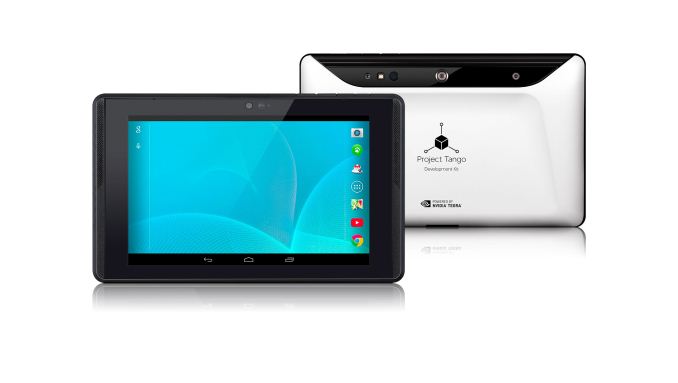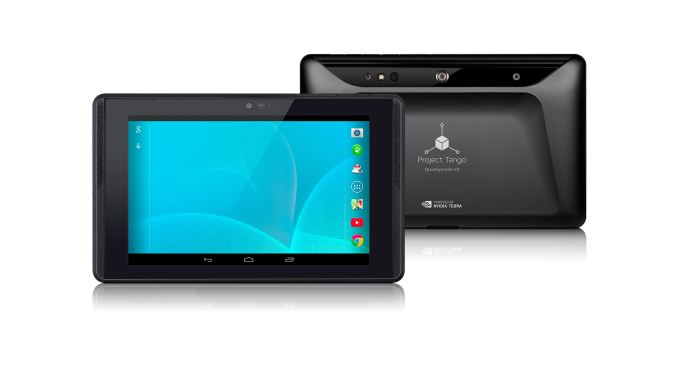Google Announces Project Tango Tablet Dev Kit with Tegra K1 and 3D Capture/Tracking
by Jarred Walton on June 5, 2014 1:18 PM EST- Posted in
- Tablets
- Mobile
- NVIDIA
- Tegra K1
- Project Tango
- 3D imaging

Google recently announced their new Project Tango Development Kit, a 7" tablet with a unique twist. At present this is a device for developers, scientists, and other research-oriented groups more than something for end users, but as with most Google projects the end goal is obviously to help create something that will end up being a useful addition to a retail product. You can read more about Project Tango, but the main point of interest is that the devices contain hardware and software that allows them to track and map 3D environments. Google states that the sensors make over a quarter million 3D measurements every second, updating its position and orientation in real-time.
It seems like if Google gets enough of these things running around the world, they could combine all that data into an impressively detailed 3D map of the entire world (well, the populated parts at least). Google Earth could certainly benefit from that sort of data, but there are plenty other uses for such technology as well. NVIDIA's blog on the subject notes that games could map out your living room (or yard, office, neighborhood, etc.), or a real estate agent (or architect) could use it to create a 3D model of a house/building and provide a virtual walkthrough for clients. Uses in the robotics field are another option, and robotics research has already seen great benefits of integrating Microsoft's Kinect sensor into various designs.
Along with the new information on Project Tango comes the announcement of the latest development kit hardware. (Note that this is the second Project Tango device; the first was a smartphone.) Compared to many tablets currently out there, the specs are quite impressive: NVIDIA Tegra K1 SoC, 4GB RAM, 128GB storage, and of course all the sensors needed to track motion and map environments. Basically, imagine a tablet/smartphone with Kinect-style sensors integrated into the product. (Update: Mantis Vision just announced that they will be providing the core 3D engine for Project Tango.) The device itself is a 7-inch tablet, though the screen resolution wasn't divulged, and it will be running the latest version of Android (KitKat 4.4).
If that sounds enticing, there are two more items you'll need to know: first is that the development kits will be made available "later this year", so this is not yet shipping hardware. Second, the cost of the development kit is $1024 (a nod to computer geeks and our infatuation with powers of two, I suppose). NVIDIA sent along two rendered images of the Project Tango tablet, showing black and white casings.
Source: NVIDIA Blog











33 Comments
View All Comments
JeffFlanagan - Thursday, June 5, 2014 - link
Congrats on not going insane with absurd paranoia like too many of our fellow tech people have, mwildtech. Slashdot and Ars have lost it completely, and it sucked to see the paranoia popping up here as well.SleepyFE - Thursday, June 5, 2014 - link
I'm not going insane. I am warning you. Do you think because you choose to give away your info people won't be interested? They will think:"That guy is just giving it away, probably bad info."JeffFlanagan - Thursday, June 5, 2014 - link
I wasn't talking to you, but read your posts. I don't buy your claim that you're not going insane.SleepyFE - Friday, June 6, 2014 - link
I'll be watching you.SleepyFE - Friday, June 6, 2014 - link
Just kidding.SleepyFE - Friday, June 6, 2014 - link
Or am i?!?!?!?ams23 - Thursday, June 5, 2014 - link
The 128GB iPad Air variant with LTE (with 1GB RAM onboard) sells for $929. Considering that Project Tango is a 128GB Google tablet variant with LTE (with 4GB RAM onboard and with a far more powerful GPU in comparison), the price for this developer-focused tablet with advanced sensors is not out of this world, so to speak.Morawka - Thursday, June 5, 2014 - link
yeah but the ipad air is 10 inches. Google should have priced this at slightly above cost. They are trying to pay for the R&D in one batch it seems. As others have stated, they priced it to high. Bill of Materials is probably $200, google could've charged $600 and got a lot more developers on board, but i dont see many developers picking this up.It's like google is targeting the "rich" developer, or more experienced successful developer, instead of letting some of the smaller dev's afford it.
fteoath64 - Friday, June 6, 2014 - link
This is exactly the point. The issue of thousands of "half hearted and mostly Windows addicted" developers will not get a device like this. In fact, they might even think twice about the K1 development kit which is less than $200. The asking price is not outrageous compared to Glass. At least this tablet has real expensive scanning hardware. I was hoping for a laser scanner unit so it can do 3D model scans if properly placed with appropriate software. A multi-functional modern scanner in a 7inch formfactor is a nice thing.The concept of creating 3D worlds like great for gaming as well. Think Minecraft. And a host of RPG games that actually use real terrains and possibly those coming from Mars in future!.
uhuznaa - Friday, June 6, 2014 - link
This thing will be manufactured in low numbers, since it wouldn't sell any better even with a lower price. It's a really fugly tablet and there will be no apps using this tech for a while. I really doubt a BOM of $200.I think it's a neat idea that fits well in with what Google does. I'm not really sure though if this is something that belongs into a tablet or smartphone. But if they can establish that, wow.